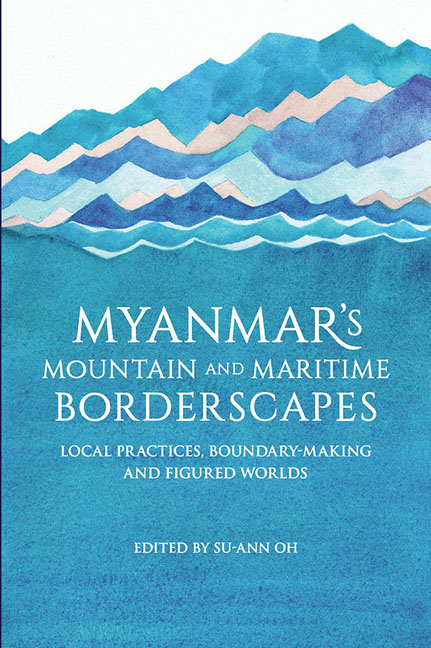Book contents
- Frontmatter
- Contents
- List of Tables
- List of Figures
- Acknowledgements
- Notes on Language, Terminology and Geographical Names
- Contributors
- Abbreviations
- 1 Introduction
- I Overview of Myanmar's Mountain and Maritime Borderscapes
- II Territorial Claims and Imagined Boundaries
- III Social Organization and Border Economies
- 7 The Culture and Landscape of the Humanitarian Economy among the Karen (Kayin) in the Borderland of Southeast Myanmar and Northwest Thailand
- 8 Navigating Learning, Employment and Economies in the Mae Sot-Myawaddy Borderland
- IV Mobile Practices and Moving Borders
- V Identity Construction and the Politics of Belonging
- VI Institutionalized Identity and Border Practices
- Index
7 - The Culture and Landscape of the Humanitarian Economy among the Karen (Kayin) in the Borderland of Southeast Myanmar and Northwest Thailand
from III - Social Organization and Border Economies
Published online by Cambridge University Press: 06 June 2017
- Frontmatter
- Contents
- List of Tables
- List of Figures
- Acknowledgements
- Notes on Language, Terminology and Geographical Names
- Contributors
- Abbreviations
- 1 Introduction
- I Overview of Myanmar's Mountain and Maritime Borderscapes
- II Territorial Claims and Imagined Boundaries
- III Social Organization and Border Economies
- 7 The Culture and Landscape of the Humanitarian Economy among the Karen (Kayin) in the Borderland of Southeast Myanmar and Northwest Thailand
- 8 Navigating Learning, Employment and Economies in the Mae Sot-Myawaddy Borderland
- IV Mobile Practices and Moving Borders
- V Identity Construction and the Politics of Belonging
- VI Institutionalized Identity and Border Practices
- Index
Summary
This chapter provides a concise map of faith-based and secular humanitarian assistance to the Karen in the Thai-Burmese borderland to show the emergence and development of a humanitarian economy for Karen villagers in southeast Myanmar, and in the nine refugee camps in northwest Thailand. I understand humanitarianism to be a culture of humanitarian aid, compassion and relief, but prefer a broader definition that includes agency which encompasses a range of services — from emergency healthcare to advocacy work, such as training for documentation of human rights violations. I suggest that decades of civil war and repression in southeast Myanmar have created a particular landscape of humanitarianism in the borderlands of southeast Myanmar and northwest Thailand that is characterized by the dense presence of local and international humanitarian organizations. The chapter advances the thesis that humanitarianism takes over state functions in the social services as the economy, health and education sector in southeast Myanmar have largely collapsed (South 2012; Decha Tangseefa 2006). Humanitarianism thus contributes in a crucial way to the consolidation of social support networks of Karen villagers and a parallel state or self-governance of the Karen in the context of open state terror and hostility.
Outlining this specific culture of humanitarianism as it developed in the Thai-Burmese borderland, I find the theory of landscape useful. Describing landscape, cultural geographers were either interested in the materiality of landscape or in the politics of representation and power. I am interested in the relationship between the two: landscape is the way in which specific actors shape a region or area with their practices and the way that a region is imagined and represented. I thus concur with Janet C. Sturgeon's claim that landscapes are more than just physical topography and land cover, but sites for manoeuvre and struggle (Sturgeon 2005, p. 3ff). Humanitarian work, in its informal and underground nature (as in southeast Myanmar), or formal and engineered (as in the camps in northwest Thailand) can be seen as what Sturgeon calls “landscape plasticity”, that is a contribution to negotiated landscapes. In this sense, landscapes are being constantly remodelled and the presence of humanitarian organizations and city-like camps contribute to shaping the materiality of the borderland (Agier 2002).
- Type
- Chapter
- Information
- Myanmar's Mountain and Maritime BorderscapesLocal Practices, Boundary-Making and Figured Worlds, pp. 171 - 190Publisher: ISEAS–Yusof Ishak InstitutePrint publication year: 2016

